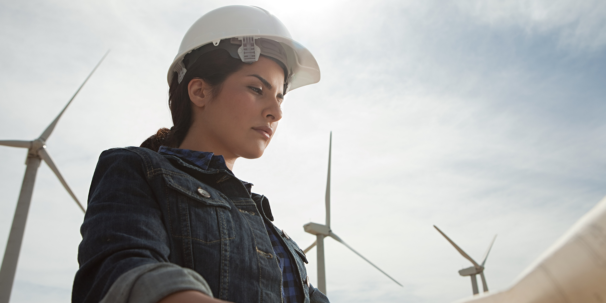The future of clean technology and sustainable technology trends
We take a closer look at what clean technology means and discuss what the future holds for the world of sustainable technology.

Sustainability is a hot topic at the minute, and with COP26 in full swing, there’s a lot of talk about sustainability and climate change. Clean technology plays an essential role in sustainable development, preserving the environment and working towards a sustainable future.
In this article, we will discuss what clean technology means, offer some examples, and look at who it benefits. We will also explore what the future holds for clean technology.
What is clean technology?
Let’s start by defining clean technology; what does it mean for technology to be clean? To put it simply, clean technology encompasses any measures taken to reduce, or preferably eliminate, negative environmental impacts whilst encouraging economic and social development.
Natural resources should be preserved or avoided if possible, and clean technology is all about working in a way that acts on the need to preserve these non-renewable resources.
Clean technology aims to eliminate or reduce pollution and waste whilst improving productivity and efficiency at the same time. These changes should be implemented throughout each step of a product or process life cycle.
The term clean technology is often used interchangeably with green technology or sustainable technology. It’s a broad term that refers to many different environmentally-friendly practices. We’ll discuss some of the types of clean technology throughout this article.
Examples of clean technology
In this current climate, many companies are making an active effort to get involved in sustainable technology. There are lots of ways to reduce your carbon footprint at the source. Let’s take a look at some of the examples of clean technology implementation.
Hydroponics
Since agriculture is a huge contributor to global warming, we need to find a solution and start implementing smart agriculture methods. One way of doing this is by utilising hydroponics. This type of eco-innovation is the growing of crops without the use of soil and instead using water enriched with nutrients.
There are many benefits of using hydroponics; it takes up less space than regular farming, crops can be grown anywhere, less water is used, and there are no seasonal limitations. That being said, this alternative to traditional farming is considerably more expensive, so not everyone can afford to make the change.
Solar power
Energy use is also a massive contributor to climate issues, so an alternative to fossil fuels and unrenewable materials is an amazing opportunity. Solar energy uses solar panels to absorb sunlight and generate electricity.
Solar energy is a renewable resource, free to use and does not leave any negative impact on the planet. We use electricity for an array of activities throughout the day, so the switch to solar energy could have a huge impact. However, similarly to hydroponics, solar panels can be expensive to initially implement. Companies such as IKEA, Apple and Microsoft are already using solar panels as a part of their business strategy.
Sustainable transportation
Transport makes up for a large portion of greenhouse gas emissions, which ultimately lead to global warming. In 2019, 29% of greenhouse gas emissions within the US were from transportation alone. We use transport for work, school, social activities and various other activities.
For something we use so often, it’s scary to see how much of an impact transport has on our environment. Thankfully, we are seeing more sustainable transportation alternatives; options like electric vehicles are now readily available and being used across the world.
As well as electric alternatives to fossil fueled transportation, additional public transport is a great way to implement clean technology. With more people using shared transportation, less personal vehicles are contributing to gas emissions.
If you’re interested in learning more about sustainable transport, check out our Transforming urban mobility course.
Recycling materials
This may seem like a simple method, but recycling and upcycling are massively powerful tools to increase sustainability efforts. Recycling comes in many forms – whether it’s individuals reusing bottles to reduce plastic waste or companies fashioning discarded items into new products, recycling is a sustainability game-changer.
Fashion sustainability, in particular, is on the rise, as more individuals become aware of the impacts of fast fashion. Many fashion brands such as Levi’s run clothing recycling schemes to recycle old clothes into new products. These brands often offer rewards and discounts as an incentive to bring in any unwanted clothes too.
For a more in-depth view on sustainability within the fashion industry, check out our Sustainable fashion Microcredential.
-

 MSQ How to Measure, Reduce, and Offset your Company’s Carbon FootprintNature & Environment,Business & Management
MSQ How to Measure, Reduce, and Offset your Company’s Carbon FootprintNature & Environment,Business & Management -

 University of Bristol Unleash Your Potential: Sustainable FuturesNature & Environment
University of Bristol Unleash Your Potential: Sustainable FuturesNature & Environment
Why is clean technology important?
We’ve touched on some of the reasons why clean technology is important throughout the article, but let’s take a closer look at why clean technology is vital. We have reached a point where our planet is in danger, and we need to work towards a sustainable future to protect it. What are some of the environmental challenges we are currently facing as a planet?
- Climate change – perhaps the most well known environmental challenge, climate change is the change in overall temperature or weather patterns of a place. Average global temperatures are increasing at an alarming rate, and without our efforts to reduce our carbon footprint, it will only continue to rise.
- Pollution – we can define pollution as the addition of a harmful substance into a natural environment. Pollution comes in the form of air pollution, water pollution, and land pollution, and all can be extremely harmful to living beings.
- Biodiversity loss – biodiversity is the variety of living things on Earth. As we explored in our extinction prevention blog post, biodiversity loss has massive implications for the planet’s wellbeing. Living creatures are dependent on the existence of other species for survival, and biodiversity loss can cause a catastrophic domino effect.
- Food waste – this refers to the food which is discarded despite being fit for human consumption. This is a huge issue we are currently facing; 1.3 billion tonnes of food is wasted every year. Food wastage occurs during each step of the process – during production, processing, distribution and even consumption.
-

 academyEX Leading Sustainable Communities and OrganisationsNature & Environment,Business & Management
academyEX Leading Sustainable Communities and OrganisationsNature & Environment,Business & Management -

 EIT Food From Waste to Value: How to Tackle Food WasteNature & Environment
EIT Food From Waste to Value: How to Tackle Food WasteNature & Environment -

 UCL (University College London) Transforming Urban Mobility: Introduction to Transport Planning for Sustainable CitiesNature & Environment,Politics & Society
UCL (University College London) Transforming Urban Mobility: Introduction to Transport Planning for Sustainable CitiesNature & Environment,Politics & Society
To find out more about this pressing issue, check out our How to tackle food waste course.
So, now we know a few of the reasons we need to implement sustainable technology, how can clean tech make a difference? Here are some of the ways sustainable technology can inflict change:
- Sustainable energy – a lot of clean tech methods work towards sustainable energy generation and usage. Electricity is consistently used around the globe, and innovations such as wind turbines, solar panels and geothermal energy can make a huge difference.
- Waste reduction – on a planet where we are rapidly running out of space, it is essential to reduce the amount of waste we send to landfills. Clean technology can be tied to any efforts to reduce waste production or even recycling.
- Water quality – often overlooked, water quality is a massive environmental issue. Many companies are making an effort to reduce water usage and provide clean water to undeveloped areas. Some ways that clean tech can be applied to water is through the use of water treatment and wastewater treatment.
Who benefits from clean technology?
When it comes down to it, we all benefit from the implementation of clean technology; each step towards sustainable technology supports the protection of our environment. It may be tricky to envision how you or your company can contribute to the Earth’s wellbeing, but every single step towards sustainability makes a difference.
Almost every industry can participate in clean technology. Even start-ups and small businesses can make an impact by implementing clean technology. Whilst some industries have significantly more negative impacts on the environment, we can all do our part to preserve natural resources.
Some of the sectors with the highest negative impact on the environment include energy, waste, and agriculture. Yet without all industries taking action, it’ll be too late to save the environment as we edge closer to the Earth’s tipping point.
Corporate sustainability and corporate social responsibility are emerging themes that encourage businesses to do their part and make a difference to our environment. To find out more about how your business could make an impact, check out our How to measure, reduce and offset your company’s carbon footprint course.
-

 Central Queensland University A Beginner’s Guide to Environmental Science: Wicked Problems and Possible SolutionsNature & Environment,Science, Engineering & Maths
Central Queensland University A Beginner’s Guide to Environmental Science: Wicked Problems and Possible SolutionsNature & Environment,Science, Engineering & Maths -

 University of Bergen Causes of Climate ChangeNature & Environment,Science, Engineering & Maths
University of Bergen Causes of Climate ChangeNature & Environment,Science, Engineering & Maths
What does the future hold for clean technology?
Sustainable living and awareness of climate change are on the rise – it’s clear that clean technology is more relevant than ever.
The demand for clean technology
With the population rising and environmental threats increasing, it really is a necessity to increase sustainability efforts across the globe. We are seeing drastic changes in our natural environment, so we need to take action before matters get worse.
Water is becoming scarce, we are seeing more and more animals face extinction and the Earth’s average temperature is soaring. Sadly, a lot of the causes for these negative changes are due to human activity, so we need to reduce these harmful actions with sustainable technology.
The green technology market was reported to be worth 11.2 billion USD in 2020, and is anticipated to reach 36.6 billion USD by the year 2025. Awareness on the topic of sustainability is growing, and along with awareness comes those willing to take action. We can expect to see clean tech in even more spaces than we currently have in the future.
The sustainable generation
The rise of sustainability awareness could be due to a generational shift in our society. Younger generations today are more environmentally-conscious and more inclined to make sustainable choices.
Reports have shown that 73% of Gen Z are willing to pay more for products if the products are sustainable. Gen Z are more likely to purchase goods based on a company’s values and environmental principles. Younger generations showing such a keen interest in the Earth’s preservation is an indicator that we can expect more clean tech in the future.
Clean technology trends
What was once an afterthought of running a business is now at the forefront of almost any business plan and operation. Let’s look at some of the ways we can expect to see clean technology trends continue to grow in the future.
Impact investing
Impact investing refers to investment in companies that provide a positive environmental impact as well as generating financial gains. These impact investments target companies that aim to make additional improvements as a core part of their business model.
The rise of impact investing only adds additional incentive to companies that are considering a clean tech approach. The world is heading towards a more sustainable way of living, and cleaner technology encourages this.
It only makes sense that investors head in this direction when the clean technology industry is growing so rapidly. With cleaner technology growing, impact investment grows with it; in 2020, the impact investment market was estimated to be worth 715 billion USD.
Smart agriculture
As we briefly mentioned , smart agriculture is a game-changer when it comes to reducing carbon emissions. The agricultural industry has huge ramifications for our planet; the livestock sector alone contributes to 44% of human-induced methane emissions.
Hydroponics is only a small aspect of the smart agriculture sector. There is a lot to unpack when it comes to the technology with areas such as precision farming and artificial intelligence being implemented within the agriculture sector.
For a more detailed look at smart agriculture, check out our Exploring climate smart agriculture course.
Artificial intelligence
This complex computer software uses machine learning to simulate human intelligence. Artificial intelligence is not just exclusive to farming; it can also be used for a wide range of other industries. AI has the ability to perform tasks with great precision, and therefore reduce huge amounts of waste, whether that’s in the form of resources or time.
AI has proven particularly useful during manufacturing processes, as it can automate many steps in the production chain. It can also reduce costs which can then be put towards additional clean tech measures.
Compulsory climate transparency for companies
Within the UK, large companies will be legally required to disclose all financial information related to climate. This legislation will come into force on the 6th of April 2022, so we can expect to see more transparency from firms regarding their commitment to sustainability.
This legislation aims to assist investors and businesses in understanding the financial implications of those involved in climate change. With the implementation of this law, companies will not be able to hide and mislead with their clean technology commitments.
COP26 impacts
Despite not being over yet, COP26 is already making a dent in climate change plans and commitments across various countries. As we explored in our What is COP26 blog post, world leaders are addressing many at the event, including gender, finance, fashion and education.
We can expect to see further developments that will be implemented once the event is over, but here are just a few of the results that have already come of COP26:
- Over 20 countries and financial institutions have pledged to halt all financing for fossil fuel development projects overseas.
- US president Joe Biden has pledged to reduce global methane emissions by 30% by the year 2030.
- Africa is preparing to spend 6 billion USD on adapting to meet climate change needs.
- India is targeting net-zero emissions by 2030.
-

 Manchester Metropolitan University The Challenge of Clean Growth and Clean CitiesNature & Environment,Science, Engineering & Maths
Manchester Metropolitan University The Challenge of Clean Growth and Clean CitiesNature & Environment,Science, Engineering & Maths
Final thoughts
We hope that this article has given you a thorough understanding of what clean technology is and what we can expect to see in the industry in the future. It’s safe to say that clean technology will continue to grow in relevance and hopefully help drive us towards a more sustainable future.
If you’re interested in learning more about eco innovation, check out our highly rated Designing for a sustainable future course.




